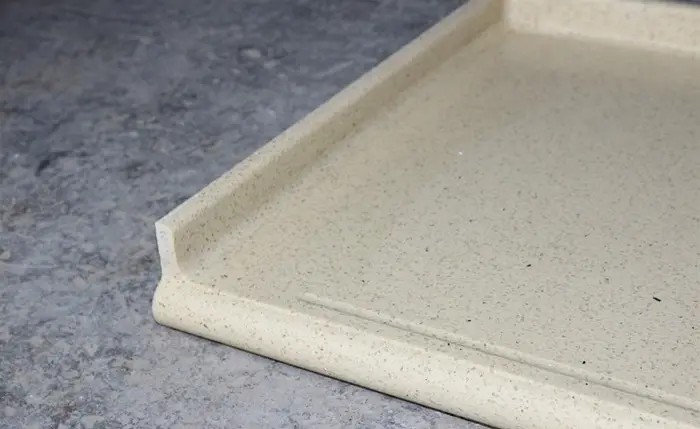How to Round Marble Corners: A Step-by-Step Guide
Rounding the corners of marble is a meticulous process that enhances the beauty and safety of your marble surface. Whether you're working on countertops, tiles, or trim, getting smooth, rounded edges requires skill and the right tools. This article outlines the grinding process for marble filleting, including the necessary tools and specific steps to follow.

Manual Processing
Before you begin, gather the following tools and materials:
1. Power tools:
Drilling: Used to create initial cuts or holes if needed.
Electric planer: Can be used to quickly remove material and shape edges.
Grinder: Essential for smoothing and shaping marble.
2. Hand tools:
Hammer: Chisel or file for tapping.
File: Refine the shape of the corners.
Scraper: Used to remove any rough spots or debris.
3. Sandpaper: Various grit sizes (from coarse to fine) are used to smooth edges.
4. Polishing fluid: Achieve a high gloss effect after rounding.
Step-by-step operation
1. Polish the marble slab
Preparation: Make sure the marble slab is clean and free of dust or debris. This will help you get through it smoothly.
Use power tools: Start by smoothing the surface of the marble using a grinder or planer. Move the tool in consistent motions, applying even pressure to avoid uneven spots.
Check for flatness: Use a ruler or level to make sure the surface is flat before proceeding to the next step.
2. Use a hand file to trim the edges
Choose the right file: Select the file that fits the desired corner shape. Round files are great for creating smooth, rounded edges.
Filing technique: Hold the file at a slight angle and work along the edge of the marble. Use controlled strokes to gradually shape the corner into the desired contour.
Regular checks: Check your progress frequently to make sure you're in the shape you want. Take your time and avoid removing too much material.
3. Polish with sandpaper
Start with Coarse Sand: Use coarse sandpaper (approximately 60-120 grit) to begin further refining the shape of the corners. Wrap sandpaper around the sanding block for better control.
Sanding technique: Sand in a circular motion or along the edge, applying even pressure. This will help eliminate any issues left over from the archiving process.
Progress to finer grits: Gradually move to finer grits (up to 400 or higher) for a smoother surface. Each grain of sand should remove the scratches left by the previous grain.
4. Polish the edges
Apply polish: After the edges are smooth, apply polish to the corners. This will enhance the marble's shine and protect it.
Polishing technique: Polish the edges with a soft cloth or the polishing pad that comes with your power tool. Move in a circular motion to ensure even application of polish.
Final inspection: After polishing, inspect the corners for any remaining imperfections. If necessary, repeat the sanding and polishing steps until you achieve the desired finish.
Machine Processing
In addition to manual operations, machine machining provides an efficient and precise method for rounding the corners of marble slabs.
1. Linear automatic rounding machine processing
Overview
Linear automatic filleting machines are designed to cut marble slabs into the desired round shape in one operation. These machines simplify the rounding process and provide smooth edges without the need for extensive additional grinding or polishing.
Notes
Tool hardness: Tools with high hardness must be used to prevent excessive wear during cutting.
Stability: Make sure the marble slab is securely held in place to prevent movement or wobbling during cutting.
2. CNC machining
Overview
CNC machining is a highly advanced method that utilizes computer-controlled machines to precisely cut and shape marble slabs. This technology enables precise control of cutting paths to create complex designs and fillets.
Notes
Tool maintenance: Regularly check cutting tools for wear and replace them as necessary to maintain processing quality.
Pre-processing inspection: Before starting the operation, verify cutting accuracy and tool condition to ensure optimal performance.
Solutions to common problems
1. The cutting edge is not smooth after rounding
Solution: If the edges are not smooth after rounding, please sand the edges with sandpaper or apply polishing fluid for final polishing. This will enhance the surface and remove any minor imperfections.
2. The marble slab moves or shakes during the cutting process
Solution: To prevent movement or wobbling during cutting, secure the marble slab with clamps or professional fixtures. Ensuring stability is critical to achieving precise cuts and preventing damage.
In Conclusion
In summary, both the manual and machine methods of marble filleting have their unique advantages. While machine machining can provide greater efficiency and precision, manual operations can still complete the task effectively within a limited budget. Ultimately, the choice of method should be guided by specific project requirements, available resources, and the level of detail required. With careful planning and attention to safety, marble fillets can be successfully achieved, enhancing the beauty and functionality of your marble surface.
 English
English  Português
Português  русский
русский  Chinese
Chinese  French
French  Japanese
Japanese  Spanish
Spanish 



